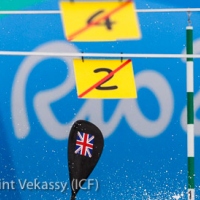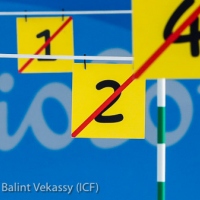50 seconds – 2 seconds or clear?
As canoe slalom evolves to shorter and tighter races with higher stakes then the margins are being shaved ever closer by the athletes. Here we examine the process on how race control determines whether a paddler’s whole head and part of the boat has passed through the gate or whether to award a 50-second penalty. I gained exclusive access behind the scenes during the C2M and K1W heats.

We encourage you to refer back to our previous blog post here titled The all seeing eye of the judge, posted on August 4.
We look at three specific 50-second penalty decisions;
- Lucien Delfour (AUS:K1M) heat 2
- Werro/Werro (SUI:C2M) heat 1
- Ana Satila (BRA:K1W) heat 2
Lucien Delfour (AUS:K1M) heat 2 – 50-second penalty on gate 20
Two gate judges awarded a 50-second penalty. On video review, the whole head was judged not to have passed through the gate line. The gate line camera was also analysed as to whether Delfour’s whole head had passed through the gate line. The SloMo video review of the OBS feed supported the view of the gate judges.
Werro/Werro (SUI:C2M) heat 1 – 50-second penalty on gate 24
The gate judges had each awarded a 50-second penalty. On video review, deliberate displacement of the downstream left pole by Lukas Werro (bib 9A) was clearly evident.

Ana Satila (BRA:K1W) heat 2 – 50-second penalty on gate 20
The gate judges had each awarded a 50-second penalty. The whole head was judged not to have passed through the gate line. On SloMo video review, including the use of the gate line camera, Satila’s whole head did not pass through the gate line.
Video review
The SloMo (slow motion video review) is a relatively new development. It was not employed at the London 2012 Olympics and has been tested through the recent World Cup series races. The SloMo platform has the added advantage of synchronising multiple camera angles. The ICF Chief Judge makes the final decision.
The smaller field and 3 minutes between competitors mean that the extensive Video Judging team has more than enough time to review penalties, where necessary, including SloMo. Eric Lokken (USA) has become very adept at this SloMo role.
A spreadsheet screen is now employed to log each instance in which a paddler’s run is video reviewed as shown in the picture. Today, the judging decisions and review is only available to the National Federation team leaders just beyond the finish line. On request, the team leaders can be provided with a file of the video used to make the decision.

If the video view is inconclusive, then here the Video Judges can request a specific OBS feed view. If still inconclusive then the decision of the gate judges is upheld. There is no perfect camera angle that can catch every instance. Anecdotally, more penalties appear to be removed than are every added under video review.
Gate line cameras
Dedicated cameras looking at the gate line of gates that are anticipated to warrant video review are now employed. This is also a new development since the London 2012 Olympics. The camera is set up at an angle to complement other camera views of the gate in question. This can then be analysed in more depth with the Dartfish 7 software.

Looking forward
One enhancement could be to extend the judging decisions to the live broadcast.
For those familiar with Formula 1 (F1) Grand Prix racing, we have now become accustomed to seeing that a named driver is under investigation by the stewards for a possible infraction on the TV broadcast. Minutes later, the TV broadcast then communicates the outcome of that stewards’ enquiry and the resulting action or penalty. This would be a wonderful step forward for canoe slalom for World Championships, World Cup series and future Olympics. Technologically, this would not be complex. Siwidata already provides the graphics including timing and penalties to the broadcast feed.
In parallel, the rules of canoe slalom also need to continually evolve to reflect the changes in the sport. Context and benefit of the doubt for the paddler still apply.
At the recent Pau World Cup, Australia’s Jess Fox was awarded a 50-second penalty based on SloMo review. While this may be technically correct, context is important in the interpretation of the rules and whether the paddler gained an advantage. In this instance, Fox’s bow got caught on the bank above the break-out. In backing up to extract the bow from the bank her head passed back through the upstream gate she had just negotiated.
In modern canoe slalom which fractions of seconds count the ICF is looking for the right wording to simplify the rules. If a paddler, needed to pass through a gate twice, perhaps there doesn’t need to be a 50-second penalty as the paddler has already penalised themselves with the additional 2-4 seconds required to complete the negotiation.
We may also ultimately advance to a stage where there is gate line camera technology on every gate.
Keep tuning in
Tune in tonight for the race analysis of C1M semi-final and final as well as a preview of the K1M semi-final.
Follow the live Olympic canoe slalom race commentary on Twitter @PlanetCanoe or search hashtag #ICFslalom





